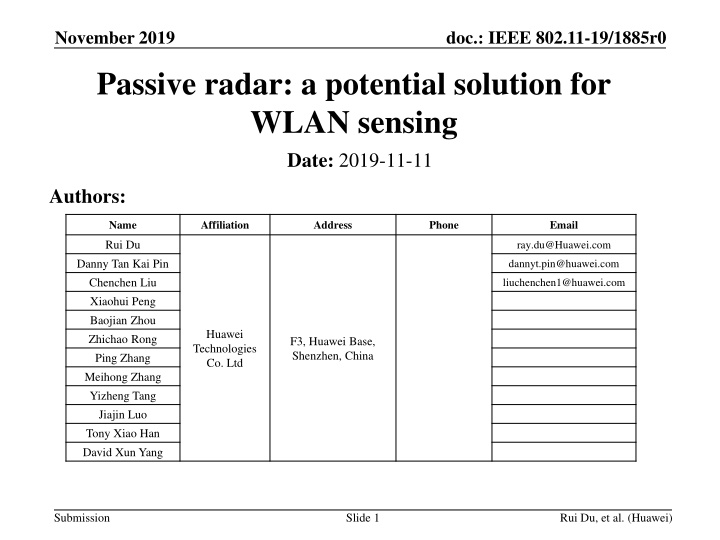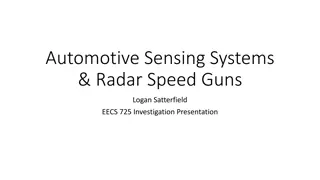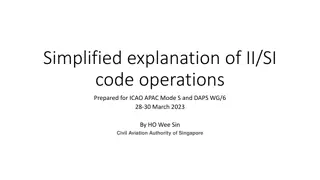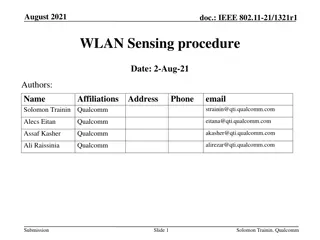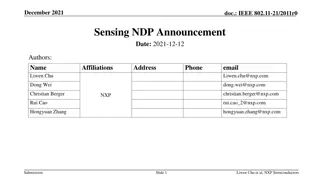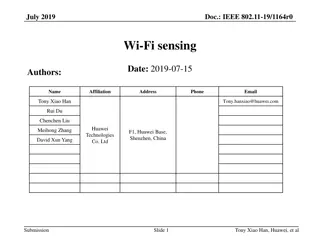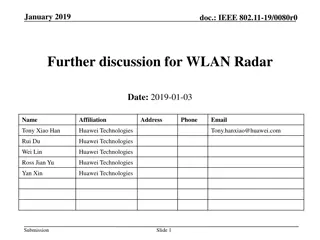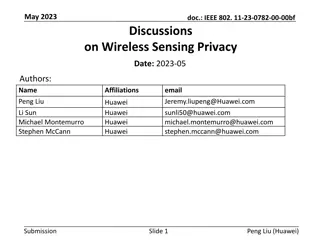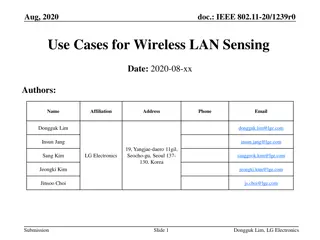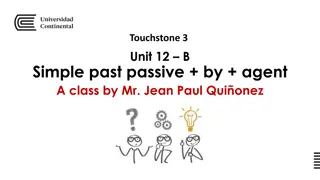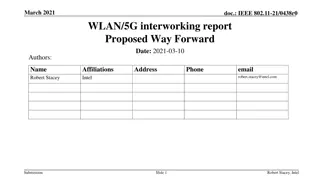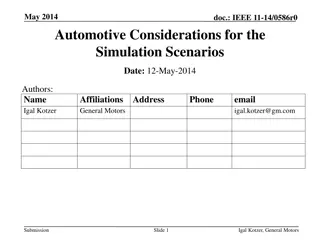Passive Radar for WLAN Sensing in Indoor Scenarios
Radar and CSI have been proposed as potential WLAN sensing techniques. This document focuses on passive radar at 5 GHz in indoor scenarios, discussing background, experimental results, signal processing techniques, and potential impacts on WLAN standards.
Download Presentation

Please find below an Image/Link to download the presentation.
The content on the website is provided AS IS for your information and personal use only. It may not be sold, licensed, or shared on other websites without obtaining consent from the author.If you encounter any issues during the download, it is possible that the publisher has removed the file from their server.
You are allowed to download the files provided on this website for personal or commercial use, subject to the condition that they are used lawfully. All files are the property of their respective owners.
The content on the website is provided AS IS for your information and personal use only. It may not be sold, licensed, or shared on other websites without obtaining consent from the author.
E N D
Presentation Transcript
November 2019 doc.: IEEE 802.11-19/1885r0 Passive radar: a potential solution for WLAN sensing Date: 2019-11-11 Authors: Name Affiliation Address Phone Email Rui Du ray.du@Huawei.com Danny Tan Kai Pin Chenchen Liu Xiaohui Peng Baojian Zhou Zhichao Rong Ping Zhang Meihong Zhang Yizheng Tang Jiajin Luo Tony Xiao Han David Xun Yang dannyt.pin@huawei.com liuchenchen1@huawei.com Huawei Technologies Co. Ltd F3, Huawei Base, Shenzhen, China Submission Slide 1 Rui Du, et al. (Huawei)
November 2019 doc.: IEEE 802.11-19/1885r0 Outline Abstract Definition of passive radar Signal processing for passive radar Range/Doppler resolution of bistatic radar Experimental measurement Measurement configurations Evaluation platforms Measurement results Potential impacts on WLAN standards Summary Submission Slide 2 Rui Du, et al. (Huawei)
November 2019 doc.: IEEE 802.11-19/1885r0 Abstract Radar and CSI had been proposed as two main potential techniques for WLAN sensing [1-2]. Measurement results of active radar for indoor scenarios at 60 GHz had been presented in September IEEE 802.11 meeting[3]. This contribution focus on WLAN passive radar at 5 GHz in indoor scenarios, relevant passive radar background and experimental results will be shown and discussed. Submission Slide 3 Rui Du, et al. (Huawei)
November 2019 doc.: IEEE 802.11-19/1885r0 1 Definition of passive radar Target Non-cooperative source RX RX (Reference CH) (Surveillance CH) Passive radar Different from active radar systems, passive radar has no dedicated transmitter. Instead, the receiver uses non-cooperative source in the environment and measures the time/Doppler difference between the signal arriving directly from the transmitter and the signal arriving via reflection from the object. Multistatic Radar Multistatic Radar Submission Slide 4 Rui Du, et al. (Huawei)
November 2019 doc.: IEEE 802.11-19/1885r0 2 Signal processing of passive radar Matched filter Time-frequency analysis Surveillance channel signal Clutter cancellation Reference channel signal The main passive radar signal processing techniques are described as follows: The direct path and static clutter signals are to be suppressed from the surveillance signal; The matched filter is used to process the clean surveillance signal and reference signal ; Time-frequency analysis is used to analyze the micro-Doppler of the target. Submission Slide 5 Rui Du, et al. (Huawei)
November 2019 3 Range/Doppler resolution of passive (bistatic) radar doc.: IEEE 802.11-19/1885r0 Range resolution: ? Target ?? = 2cos? 2? ? ? is the speed of light; ? is defined as the bistatic angle; ? is the bandwidth of the signal. The relationship of target s speed and doppler velocity and the doppler resolution: ??=2? ?cos?cos ? is the target velocity; ? is the wavelength corresponding to the carrier frequency; ? is the angle between the target s velocity and angular bisector of bistatic angle ? ???? is the coherent processing interval. ? ?/2 ?? ?? ? 2 1 ?? = ?? ???? ?? Rx Tx ? Dual channel passive radar Baseline * Please note that when ? = 0, the analysis above on could be applied for monostatic radar. Submission Slide 6 Rui Du, et al. (Huawei)
November 2019 doc.: IEEE 802.11-19/1885r0 4.1 Measurement configurations Measurement configurations: Location: F3-5-A19R @ Huawei, Shenzhen Campus Measurement area: 3m 4m Transmitter Signal format: 802.11ax Carrier frequency: 5.35GHz Bandwidth: 20 MHz Range resolution: 7.5m (for monostatic radar) Antenna pattern: Omnidirectional EIRP: 20 dBm Receiver Number of channels: 1 reference channel and 1 surveillance channel Antenna pattern: V-16 , H-16 Antennas polarization: V-V z Trans mitter Reference channel y Recei ver Surveillance channel Measurement Area x Submission Slide 7 Rui Du, et al. (Huawei)
November 2019 doc.: IEEE 802.11-19/1885r0 4.2 Evaluation platforms Transmitter Transmitter 1 omnidirectional antenna The transmitter platform is based on WLAN Toolbox in MATLAB and Zynq SDR. IEEE 802.11ax WLAN waveforms are generated by the WLAN Toolbox, and passed to the Zynq SDR for transmission via hardware support package. Reference channel Receiver USRPX310 The receiver platform is based on Ettus USRP X310 SDR. The signal is received via USRP Hardware Drive(UHD), and the received signal is processed offline in matlab. UHD Offline signal processing Surveillance channel Receiver 1 Reference channel 1 surveillance channel Submission Slide 8 Rui Du, et al. (Huawei)
November 2019 doc.: IEEE 802.11-19/1885r0 4.3.1 Measurement results Walking Doppler frequency (Hz) 20 -50 15 0 10 50 5 http://www.clipartpanda.com/c lipart_images/walk-clipart- black-and-white-38665509 2 4 Time (s) 6 8 A human target walking towards the passive radar, making a U-turn and walking away from the radar and so on. Submission Slide 9 Rui Du, et al. (Huawei)
November 2019 doc.: IEEE 802.11-19/1885r0 4.3.2 Measurement results Hand push Doppler frequency (Hz) 20 -50 15 0 10 50 https://www.shutterstock.com/ zh/search/pushing+hand+vect or?image_type=illustration 5 2 4 Time (s) 6 8 A human target doing a hand push and retracting at approximately 3 meters away from the passive radar. Submission Slide 10 Rui Du, et al. (Huawei)
November 2019 doc.: IEEE 802.11-19/1885r0 4.3.3 Measurement results Squat Doppler frequency (Hz) 20 -50 15 0 10 50 https://ya- webdesign.com/explore/squ at-vector-deadlift/ 5 2 4 Time (s) 6 8 A human target squatting and standing up at approximately 3 meters away from the passive radar. Submission Slide 11 Rui Du, et al. (Huawei)
November 2019 doc.: IEEE 802.11-19/1885r0 4.3.4 Measurement results Falling Doppler frequency (Hz) 20 -50 15 0 10 https://hearinghealthmatters.o rg/dizzinessdepot/2018/auto matic-fall-detection-a-step- in-the-right-direction/ 50 5 2 4 Time (s) 6 8 A human target mimicking a fall and standing up at approximately 3 meters away from the passive radar. Submission Slide 12 Rui Du, et al. (Huawei)
November 2019 doc.: IEEE 802.11-19/1885r0 5 Potential impacts on WLAN standards Sensing result feedback Multiple Beams Two beams (reference channel and surveillance channel); Multi beams (one reference channel and multiple surveillance channels); Multiple devices Idle devices (AP/STA) could participate passive sensing, the cooperation between different nodes could be discussed; Others Submission Slide 13 Rui Du, et al. (Huawei)
November 2019 doc.: IEEE 802.11-19/1885r0 Summary The definition of passive radar and relevant range/Doppler resolutions are discussed. The feasibility of detecting target with WLAN passive radar operating at 5 GHz is validated, and more tests could be conducted in the future. The potential impacts on WLAN standards are discussed. Submission Slide 14 Rui Du, et al. (Huawei)
November 2019 doc.: IEEE 802.11-19/1885r0 References [1] 11-19-1164-00-0wng-wi-fi-sensing.pptx [2] 11-19-1500-00-0wng-wi-fi-sensing-follow-up.pptx [3] 11-19-1551-00-0wng-wi-fi-sensing-in-60ghz-band.pptx Submission Slide 15 Rui Du, et al. (Huawei)
